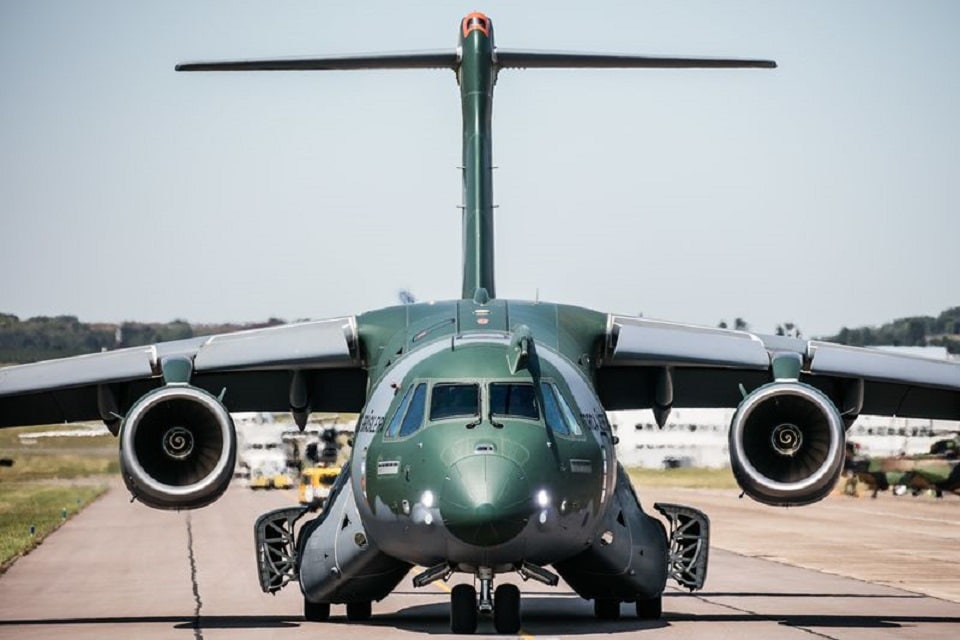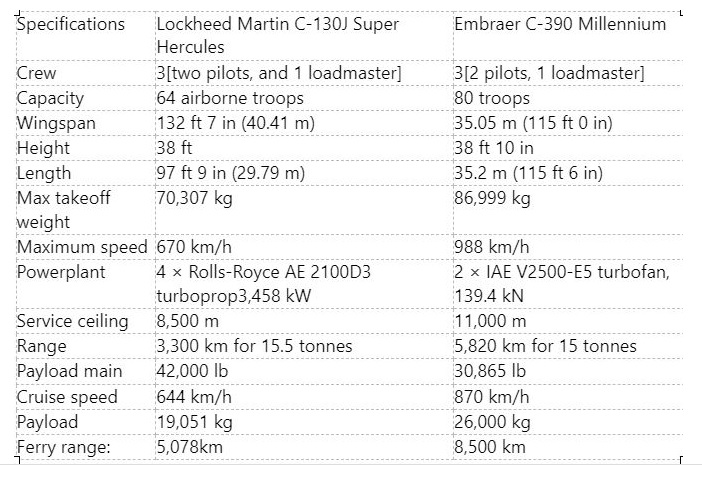Aerospace
Comparison of the Embraer KC-390 Vs the Lockheed Martin C-130J cargo plane.

In this article, we going to compare the Embraer KC 390 and Lockheed Martin C130j, Both aircraft are majority used for military transport purposes. 130J was introduced in the year 1999 and the Embraer KC 390 in 2019, it is the largest aircraft ever built by Embraer.
The KC-390 was meant to compete with the Lockheed Martin C-130J Super Hercules on the military tactical air lifter market, and it provides stiff competition for its American counterpart. When compared to the C-130J, the KC-390 is predicted to be 15% faster, carry 18% greater cargo, and cost 41% less to purchase.
Despite having a 15% lower range than the C-130J, the KC-390 includes aerial refueling as a standard feature (only a few specialized sub-variants of the C-130 have an aerial refueling capability).
Lockheed Martin C-130J
The Lockheed Martin C-130J Super Hercules, which was introduced in 1999 and has four turboprop engines, is mostly used as a military transport aircraft. The Lockheed C-130 Hercules, which originates from US states, has received a full upgrade with the C-130J that contains new engines, a flying deck, and other equipment.
The C-130J is the only model of the C-130 Hercules that is currently produced. Recently in March 2022, the 500 C-130J aircraft were delivered to 26 operators in 22 different countries.
The Royal Air Force [RAF] of the United Kingdom has given it to launch the J-model. Before delivery might occur, Lockheed Martin’s contracts with some future customers, including the United States Air Force (USAF) and the Royal Australian Air Force, were pursued.
This has to be done to speed up the sale of the military and commercial versions of the aircraft. Lockheed Martin had spent over US$900 million in development costs for the C-130J.
The USAF and USMC have made extensive use of the Super Hercules in Iraq and Afghanistan. Moreover, Canada has sent CC-130J planes to Afghanistan. Over 1 million flight hours have been recorded by C-130J Super Hercules aircraft from 13 different countries.
A self-contained unit that can be loaded, the Modular Airborne Firefighting System (MAFFS) is used for aerial firefighting . That can be loaded onto a C-130 Hercules, which then allows the aircraft to be used as an air tanker against wildfires.
The United States Air Force is currently the largest operator of the C-130J, having placed increasing quantities of orders for the aircraft. 500 units had been created overall as of March 2022.
It operates in many nations, like Algeria, Australia, Bangladesh, Canada, Denmark, France, Germany, India, Oman, Qatar, and Saudi Arabia… It can carry 92 passengers and has a maximum takeoff weight of 155,000 lb (70,307 kg).
KC390
The EMBRAER KC-390 took to the skies for the first time in 2015. The first deliveries to the Brazilian Air Force were supposed to commence in 2016. Despite the fact that these plans have been postponed until 2018,
The horizontal stabilizer is installed on top of the vertical stabilizer in an “all-flying tail” T-shaped layout on military cargo aircraft. The cargo hold can hold up to three cars, each weighing up to 23 metric tonnes.
The Embraer C-390 Millennium is a medium-sized, twin-engine, jet-powered military transport aircraft. It was made by the Brazilian aerospace company Embraer and it has a carrying load capacity of 26 tons [57000 Ib].
The aircraft can be designed to accomplish a variety of traditional operations, including troop, VIP, and cargo transportation, as well as more specialized logistical operations, like aerial refueling as a tanker. It is the company’s heaviest airplane to date.
The first production aircraft was delivered to the Brazilian Air Force on 4 September 2019. During the Dubai Airshow, Embraer announced the aircraft’s new name for the global market, C-390 Millennium.
Embraer intended to use the closed-loop fly-by-wire, synthetic vision, and rear ramp of the mature Embraer 190 (E190) aircraft along with its wing and GE CF34 engine to power a cargo hold cabin. With a rear ramp for loading and unloading a variety of cargo, the transport aircraft will combine many of the technological innovations featured in the Embraer E-Jet family series.
Based on the initial development of the aircraft, the Brazilian government expected to invest roughly US$33 million. The development and construction of two prototypes will cost Embraer $1.5 billion.
By 2014, seven different countries had ordered a total of 68 KC-390s. Argentina has six, Brazil has twenty-eight, Chile has six, Colombia has twelve, the Czech Republic has two, and Portugal has one (5-6).
In addition to the aircraft already ordered, the Brazilian military intends to purchase another 100. France also intended to buy 12 KC-390s. Embraer offered KC 390 aircraft to India, which is currently served by Russian-built AN 32, IL76, Boeing C17, and C130J Hercules.
C130J
It is a four-engine turboprop military transport aircraft.
The First flight was introduced in 1996.
It is manufactured by Lockheed Martin.
National origins from the United States.
In May 1998, Lockheed had spent over US$900 million in development costs for the C-130J.
The C-130J’s cargo compartment is approximately 41 feet (12.5 m) long, 9 feet (2.74 m) high, and 10 feet (3.05 m) wide, and loading is from the rear of the fuselage.
It operates in many countries like Algeria, Australia, Bangladesh, Canada, Denmark, France, Germany, India, Qatar, and Saudi Arabia.
KC390
It is a twin-engine, jet-powered military transport aircraft.
The First Flight was introduced in 2019.
It is manufactured by Embraer Defense Security.
National origins from Brazil.
On 14 April 2009, Embraer was awarded with a $1.5 billion contract to develop and build two prototypes
Embraer built the C-390 around the 18.5 m (61 ft) long, 3.45 m (11.3 ft) wide, and 2.95 m (9 ft 8 in) high hold with a rear ramp.
It operates in some countries like Brazil, Hungary, Netherlands and Portugal.


Aerospace
When Ratan Tata was denied entry to the airfield at the Aero India show, he waited

During our visit to Aero India 2019, we had the unexpected opportunity to see Ratan Tata at the event, which was a thrilling moment for us. However, there was a surprising hiccup when the security staff didn’t allow him to enter due to a lack of a security pass.
Despite this, he remained calm and patiently waited for about 20 minutes until a member of the Tata team brought him the required pass, after which he calmly proceeded inside. It was a humbling sight, showcasing his composed demeanor even in such situations.
Ratan Tata ji is not only a renowned industrialist but also a trained pilot, holding a pilot’s license. In 2007, he became the first Indian civilian to fly the F-16 Falcon during the Aero India show in Bangalore—a proud moment for the nation.
His passion for aviation extended beyond flying, as he played a key role in shaping India’s aerospace industry. Under his leadership, Tata ventured into manufacturing and maintaining aerospace components while upholding its legacy of quality. Notably, Tata’s collaboration with Airbus to develop and manufacture the C295 aircraft is a testament to its growing influence in the sector.
-

 Aviation2 months ago
Aviation2 months agoMicrosoft Flight Simulator Raises $3 Million to Bring Back the An-225 Mriya
-

 Airlines2 months ago
Airlines2 months agoQantas Engineers Stage Walkout Over Cost of Living Concerns
-

 Airlines2 months ago
Airlines2 months agoQatar Citizens Can Travel to the United States Without a Visa
-

 Aviation2 months ago
Aviation2 months agoQatar Airways bans these new Electronic Devices on plane
-

 Airlines2 months ago
Airlines2 months agoJapan Airlines Rolls Out Free Domestic Flights to International Passengers
-

 Defence2 months ago
Defence2 months agoWhich Country Has the Largest Fleet of Fighter Aircraft?
-

 Airport2 months ago
Airport2 months agoWestern Sydney Airport Welcomes Its First Plane After 6 Years of construction
-

 Aviation2 months ago
Aviation2 months agoDid you know ? Once Boeing 747 carried 1088 passenger in 1991








